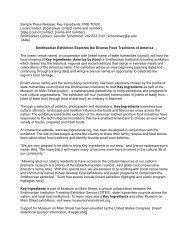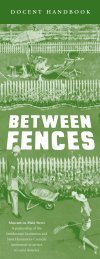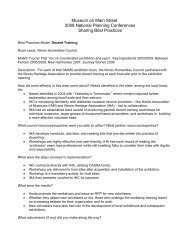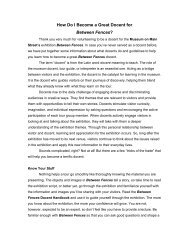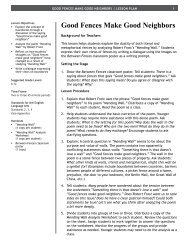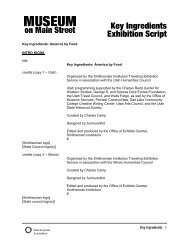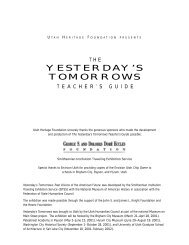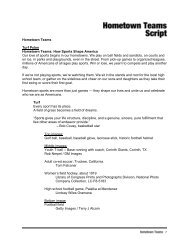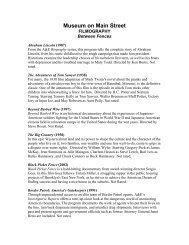Exhibition Script - Museum on Main Street
Exhibition Script - Museum on Main Street
Exhibition Script - Museum on Main Street
Create successful ePaper yourself
Turn your PDF publications into a flip-book with our unique Google optimized e-Paper software.
The Way We Worked scriptFarm woman using her electric mangle, M<strong>on</strong>tgomery County, Indiana,--by J.M. Butzko, August 12, 1930.Nati<strong>on</strong>al Archives, Records of the Extensi<strong>on</strong> ServiceEastman interview (2000) from Remembering the 20 th Century: AnOral History of M<strong>on</strong>mouth County.--Courtesy M<strong>on</strong>mouth County Library, New JerseyUSE CAUTION“We [tested for radioactive residues] desks, drawer handles, any placewhere people were and the things [workers] touched.“I remember <strong>on</strong>e time we had to rope off the entire lab wing because ananalyst . . . c<strong>on</strong>taminated a hallway by spilling something <strong>on</strong> the floor andthen walked around with it <strong>on</strong> his shoe.”– Henry Peters<strong>on</strong>, former technician at the Idaho Nati<strong>on</strong>al LaboratoryTechnology made some jobs safer, but it also created dangerous jobsthat were unimaginable 100 years ago. Human experience is still crucialto read data and maintain safety.Operating a nuclear power plant turbine in Fort St. Vrain, Colorado,--by Bruce McAllister, May 1972.Nati<strong>on</strong>al Archives, Records of the Envir<strong>on</strong>mental Protecti<strong>on</strong> AgencyPeters<strong>on</strong> interview (1999) from Proving the Principle: A History of theIdaho Nati<strong>on</strong>al Engineering and Envir<strong>on</strong>mental Laboratory, 1949–1999,--by Susan M. StacyHANDCRAFTED“One day, <strong>on</strong>e of the young boys came up to me and he said, ‘The piece Iwant is this shape, but we cannot do it. . . . Is there any other place whereI can send the job out?’ . . .“I said I would rough it out <strong>on</strong> the milling machine, and <strong>on</strong> the lathe,and <strong>on</strong> the grinder, to get as close as possible, and then after Iwould freehand it. . . . I finished it completely by hand, with a file.”– Michel Bilger, was a toolmaker apprentice when he was 15 yearsoldThe skill of working by hand is increasingly rare. Yet surge<strong>on</strong>s,carpenters, and jewelers are am<strong>on</strong>g the many craftsmen whoknow, the most precise tools are their hands.Worker at Hamilt<strong>on</strong> Watch Company, Lancaster, Pennsylvania,--by Lewis W. Hine, ca. 1936–37.Nati<strong>on</strong>al Archives, Records of the Work Projects Administrati<strong>on</strong>13



